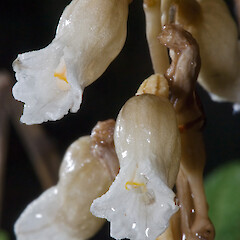Gastrodia sesamoides
Common name
gastrodia, pot-bellied orchid, cinnamon sticks
Synonyms
None
Family
Orchidaceae
Flora category
Vascular – Native
Endemic taxon
No
Endemic genus
No
Endemic family
No
Structural class
Orchids
NVS code
The National Vegetation Survey (NVS) Databank is a physical archive and electronic databank containing records of over 94,000 vegetation survey plots - including data from over 19,000 permanent plots. NVS maintains a standard set of species code abbreviations that correspond to standard scientific plant names from the Ngä Tipu o Aotearoa - New Zealand Plants database.
GASSES
Chromosome number
2n = 38-40
Current conservation status
The conservation status of all known New Zealand vascular plant taxa at the rank of species and below were reassessed in 2017 using the New Zealand Threat Classification System (NZTCS) – more information about this can be found on the NZTCS website. This report includes a statistical summary and brief notes on changes since 2012 and replaces all previous NZTCS lists for vascular plants.
Please note, threat classifications are often suggested by authors when publications fall between NZTCS assessment periods – an interim threat classification status has not been assessed by the NZTCS panel.
- Conservation status of New Zealand indigenous vascular plants, 2017 . 2018. Peter J. de Lange, Jeremy R. Rolfe, John W. Barkla, Shannel P. Courtney, Paul D. Champion, Leon R. Perrie, Sarah M. Beadel, Kerry A. Ford, Ilse Breitwieser, Ines Schönberger, Rowan Hindmarsh-Walls, Peter B. Heenan and Kate Ladley. Department of Conservation. Source: NZTCS and licensed by DOC for reuse under the Creative Commons Attribution 4.0 International licence.
2017 | Not Threatened | Qualifiers: SO
Previous conservation statuses
2012 | Not Threatened
2009 | Not Threatened
2004 | Not Threatened
Distribution
Indigenous. New Zealand: North Island, South Island (Marlborough and Nelson). Also Australia, South Africa (introduced and naturalised).
Habitat
Coastal to montane (up to 1000 m as.l.). Favouring disturbed habitats, coastal wetlands and associated shrublands, gumland scrub, and open sites along forest margins or in secondary regrowth. Often found in plantation forestry, and also occasionally found in urban areas often in traffic islands or public plantings, where it seems to be associated with pine bark mulch.
Detailed description
Terrestrial, saprophytic, deciduous, fleshy, perennial herb lacking chlorophyll. Plant at flowering up to 1 m tall. Rhizome up to 80 × 30 mm, tuberous, elongated, swollen, mycorrhizal, pale pinkish-brown to brown to brownish-black, often covered in chartaceous scales and scale-leaves, especially toward the active apex. Stem 2–7 mm diameter, dark brown to brown with lighter brown coloured, small spots, erect, stout or slender, rather brittle when fresh. Scale leaves widely spaced, chartaceous. Flowers mostly fewer than 20, mostly unscented, sometimes faintly scented; pendulous such that dorsal sepal frequently touches the stem axis. Perianth 10–16 × 4–8 mm, basally light brownish or mustard, pinkish or pinkish cream toward apex, unspotted, smooth, rarely with a few small tubercules; lobes slightly thickened toward margins. Lateral sepals fused almost to level of labellum-tip. Labellum 10 × 4 mm, white, cream, or yellowish, membranous above, thickened below, somewhat irritable, completely enclosed within floral tube (apex just visible), ovate-oblong, trilobed, base shortly fused to gibbous perianth-tube, lateral-lobes with upturned, irregular, crenate, margins; mid-lobe yellowish with flat but irregular margins, bearing several long median, verrucose, cristate, pinkish-white or cream calli. Column almost as tall as labellum, very narrowly winged throughout; anther terminal, erect and bending forwards, short and broad, operculate, filament smooth, pollen breaking into angular granules; stigma basal, set well apart from and far below anther, broad, hollow; rostellum flap-like, positioned under anther.
Manaaki Whenua Online Interactive Key
Similar taxa
Easily distinguished by its ecology—as this species frequents coastal wetlands and favours disturbed habitats such that it is often found in in locations completely overrun by naturalised plants. Gastrodia sesamoides has paler, flowers than the other two New Zealand species, and they lack spots and have a mostly non-tuberculate, smooth surface. Of critical diagnostic importance is that the column is almost the same length at the labellum.
Flowering
August–March
Flower colours
Brown, Red/Pink
Fruiting
October–May
Propagation technique
A saprophytic species which should not be removed from the wild. Difficult to grow.
Etymology
gastrodia: Belly tooth (flower centre)
Where To Buy
Not Commercially Available
Cultural Use/Importance
New Zealand plants differ somewhat from Australian plants of G. sesamoides (from where it was first described) and they probably warrant formal separation at species rank.
Attribution
Description adapted from Moore and Edgar (1970)
References and further reading
Moore LB, Edgar E. 1970. Flora of New Zealand, Volume II. Indigenous Tracheophyta: Monocotyledones except Gramineae. Government Printer, Wellington, NZ. 354 p.
Rolfe J. 2017. Guide to New Zealand Gastrodia (Orchidaceae) (pdf, 5Mb).








